- | Healthcare Healthcare
- | State Testimonies State Testimonies
- |
Tennessee's Certificate-of-Need Program: Lessons from Research
Testimony before the Tennessee Certificate-of-Need Working Group
Representative Sexton, Senator Watson, and distinguished members of the working group:
My name is Matthew Mitchell. I am an economist at the Mercatus Center at George Mason University, where I am an adjunct professor of economics. In recent years, my colleagues and I have been studying certificate-of-need (CON) laws in healthcare. I am grateful for the opportunity to discuss our findings with you today.
Introduction to CON Laws
CON laws require healthcare providers wishing to open or expand a healthcare facility to first prove to a regulatory body that their community needs the services the facility would provide. The regulations are typically not designed to assess a provider’s qualifications or safety record. Other regulations such as occupational licensing aim to do that. Instead, CON laws aim to determine whether or not a service is economically viable and valuable.
The process for obtaining a CON can take years and can cost tens or even hundreds of thousands of dollars in preparation costs. While these regulations appear to benefit incumbent providers by limiting their competition, their effects on patients and taxpayers have generally been found to be negative. This helps explain why antitrust authorities at the Federal Trade Commission (FTC) and at the US Department of Justice (DOJ) have long taken the position that these rules are anticompetitive. In a joint report from 2004, for example, the FTC and DOJ declared,
The Agencies believe that, on balance, CON programs are not successful in containing health care costs, and that they pose serious anticompetitive risks that usually outweigh their purported economic benefits.
In the remainder of my testimony today, I will offer a brief history of CON laws, a comparison of Tennessee’s CON program to the programs in surrounding states, an overview of the economic evidence that has led many to conclude that these laws pose anticompetitive risks to consumers and taxpayers, and finally, some suggestions for reform.
A Brief History of Certificate-of-Need Regulation
More than four decades ago, Congress passed and President Ford signed the National Health Planning and Resources Development Act of 1974. The statute enabled the federal government to withhold federal funds from states that failed to adopt CON regulations in healthcare.
New York had already enacted the first CON program in 1964; by the early 1980s, with the federal government’s encouragement, every state except Louisiana had implemented some version of a CON program. Policymakers hoped these programs would restrain healthcare costs, increase healthcare quality, and improve access to care for poor and underserved communities.
In 1986—after Medicare changed its reimbursement practices and as evidence mounted that CON laws were failing to achieve their stated goals—Congress repealed the federal act, eliminating federal incentives for states to maintain their CON programs. Since then, 15 states, representing about 40 percent of the US population, have done away with their CON regulations and many have pared them back. A majority of states still maintain CON programs, however, and vestiges of the National Health Planning and Resources Development Act can be seen in the justifications that state legislatures offer in support of these regulations.
Certificate-of-Need Regulation in Tennessee
Tennessee’s CON program is one of the more comprehensive CON programs in the country. Among many other things, Tennessee’s program regulates burn units, neonatal intensive care units, hospice care, opiate addiction treatment centers, and psychiatric care facilities. Table 1 shows the number of technologies and procedures regulated by Tennessee and surrounding states. Nationally, the average number of technologies and procedures regulated among CON states is 16. Tennessee regulates 26 technologies and procedures.
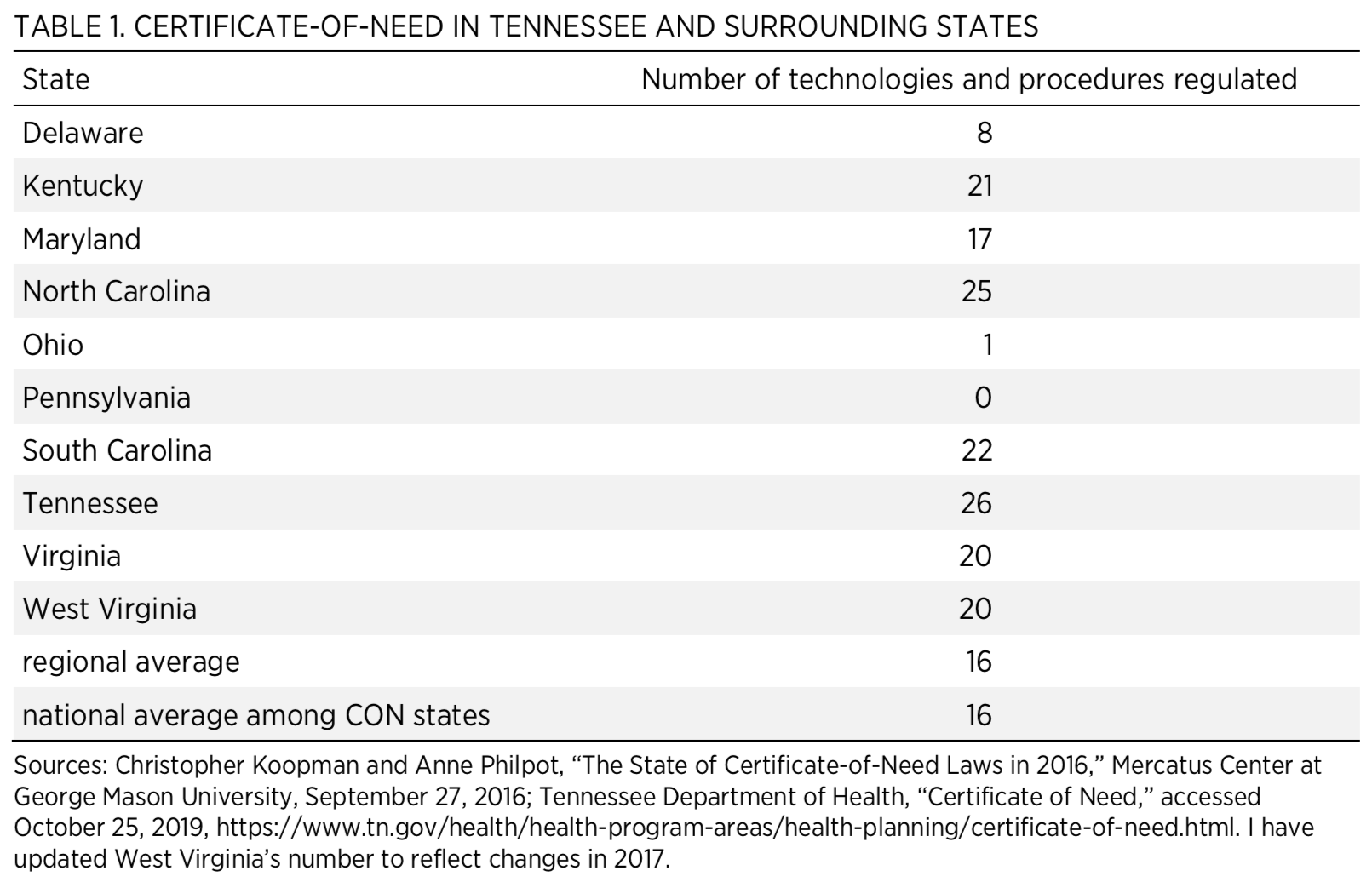
Table 2 shows the specific procedures and technologies that require a CON in Tennessee. The state requires CONs for several services that are unlikely to be overprescribed, such as neonatal intensive care and hospice care. The state also requires CONs for care that serves vulnerable populations, such as those with opiate addiction and those with mental health problems. Many of the regulated services can be provided without expensive capital investments (home health, for example). And many of these services are lower-cost alternatives to care such as ambulatory surgery treatment and hospice care.
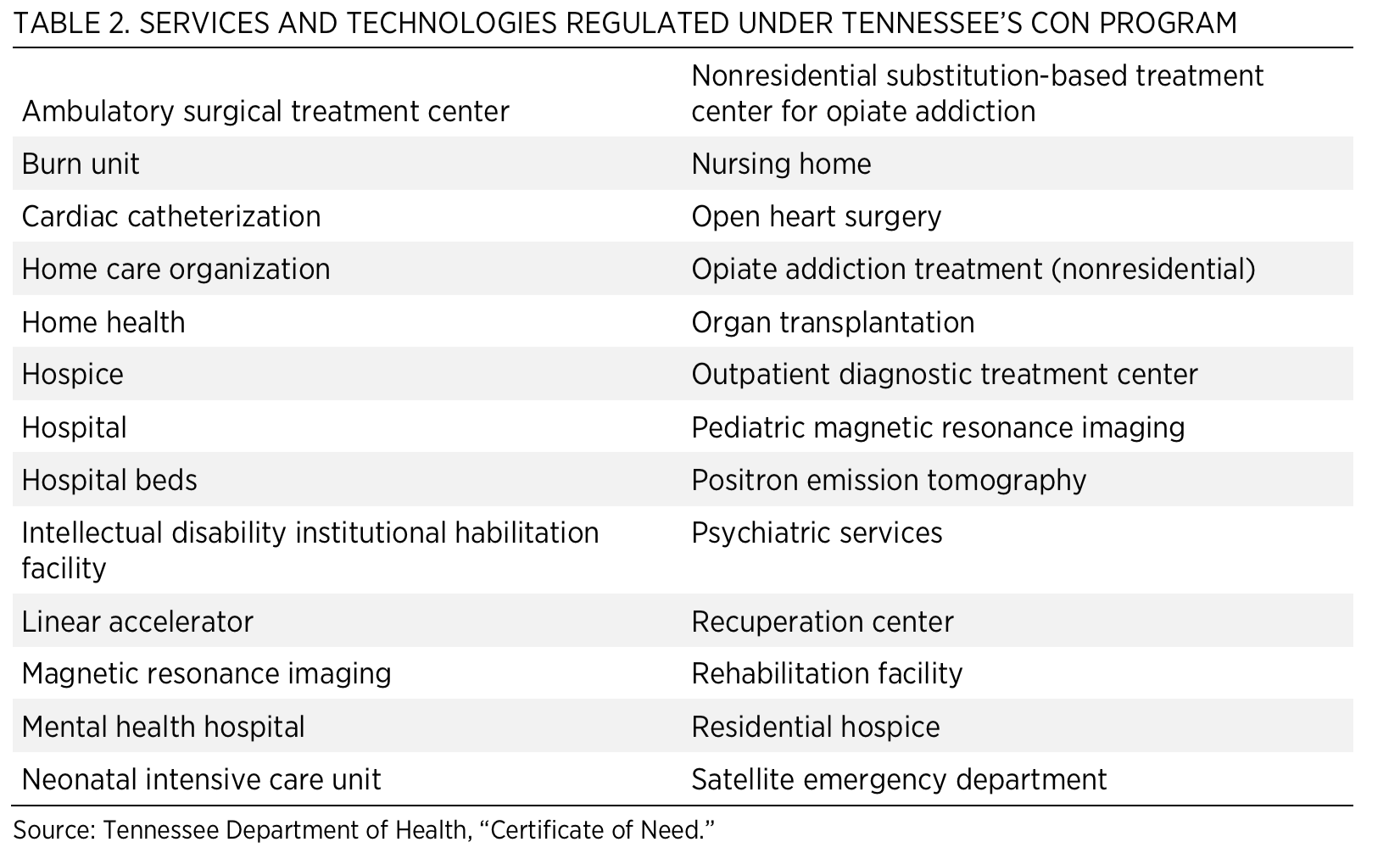
The Economics of Certificate-of-Need Regulation
Unfortunately, by limiting supply and undermining competition, CON laws may undercut each of the laudable aims that policymakers desire to achieve with CON regulation. In fact, research shows that CON laws fail to achieve the goals most often given when enacting such laws. These goals include
- ensuring an adequate supply of healthcare resources,
- ensuring access to healthcare for rural communities,
- promoting high-quality healthcare,
- ensuring charity care for those unable to pay or for otherwise underserved communities,
- encouraging appropriate levels of hospital substitutes and healthcare alternatives, and
- restraining the cost of healthcare services.
We have quite a bit of information to help predict what would happen if other states such as Tennessee were to repeal their laws because 15 states have repealed their CON programs. Economists have been able to use modern statistical methods to compare outcomes in CON and non-CON states to estimate the effects of these regulations. These methods control for factors such as socioeconomic conditions that might confound the estimates. Table 3 summarizes some of this research. It is organized around the stated goals of CON laws.
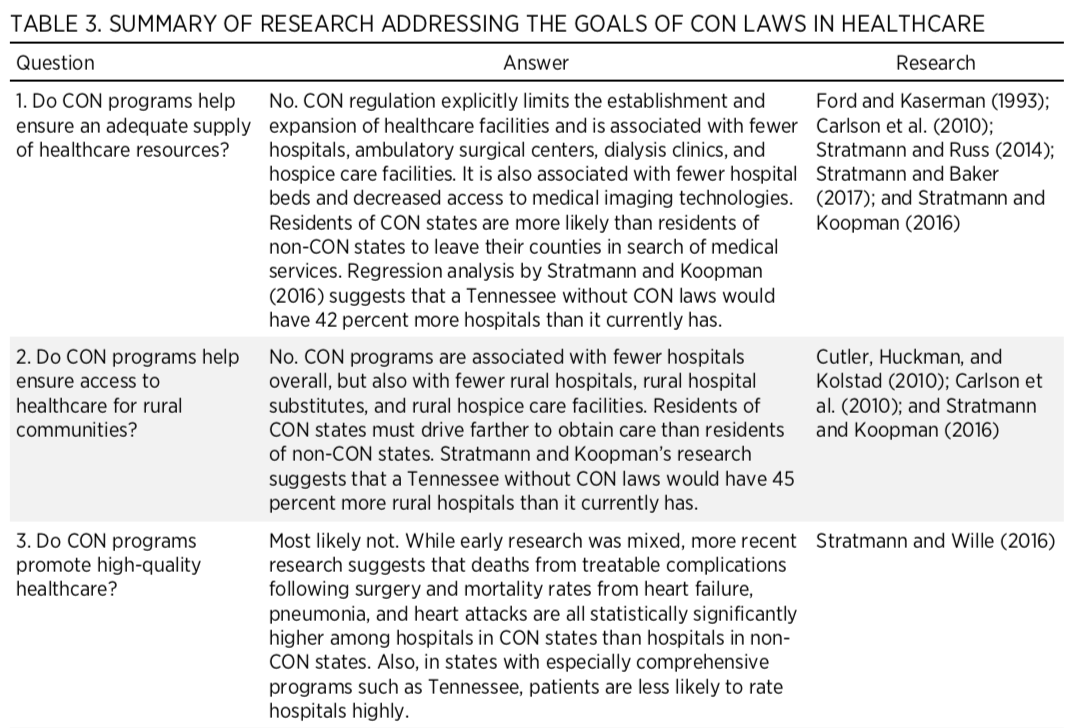
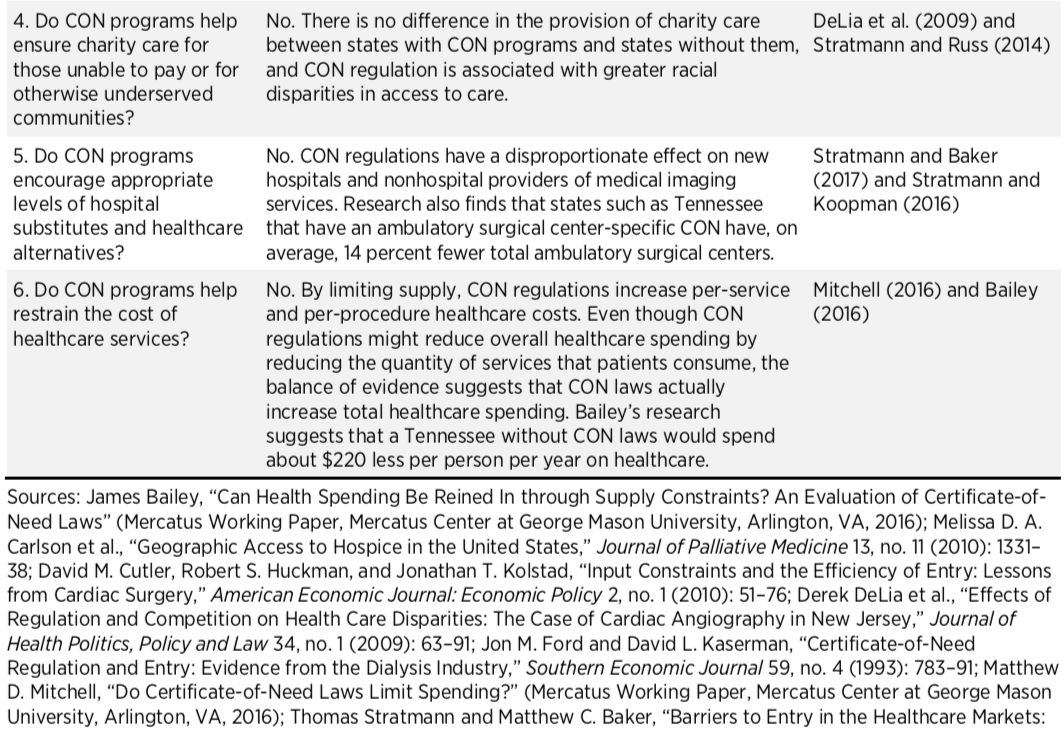

Based on the experiences of other states, one can estimate what fiscal and health outcomes might be in Tennessee if the state had no CON laws. These estimates are derived from cross-state regression analyses that track outcomes over decades. They account for socioeconomic differences as well as differences in the underlying health of the state populations.
Figure 1 shows the actual number of hospitals and ambulatory surgery centers (ASCs) as well as the estimated number of hospitals and ASCs in a Tennessee without CON laws.
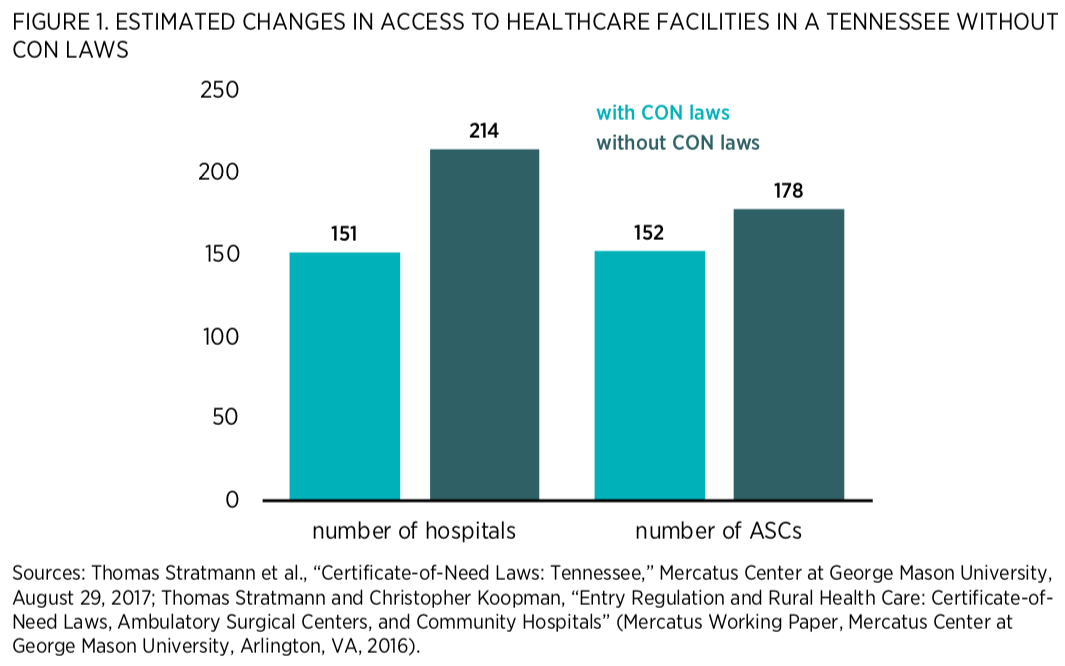
Tennessee’s rural hospitals are dying off, so CON’s effect on rural care is especially important to the state’s rural communities. Figure 2 shows the actual as well as the estimated number of rural hospitals and rural ASCs in a Tennessee without CON laws.
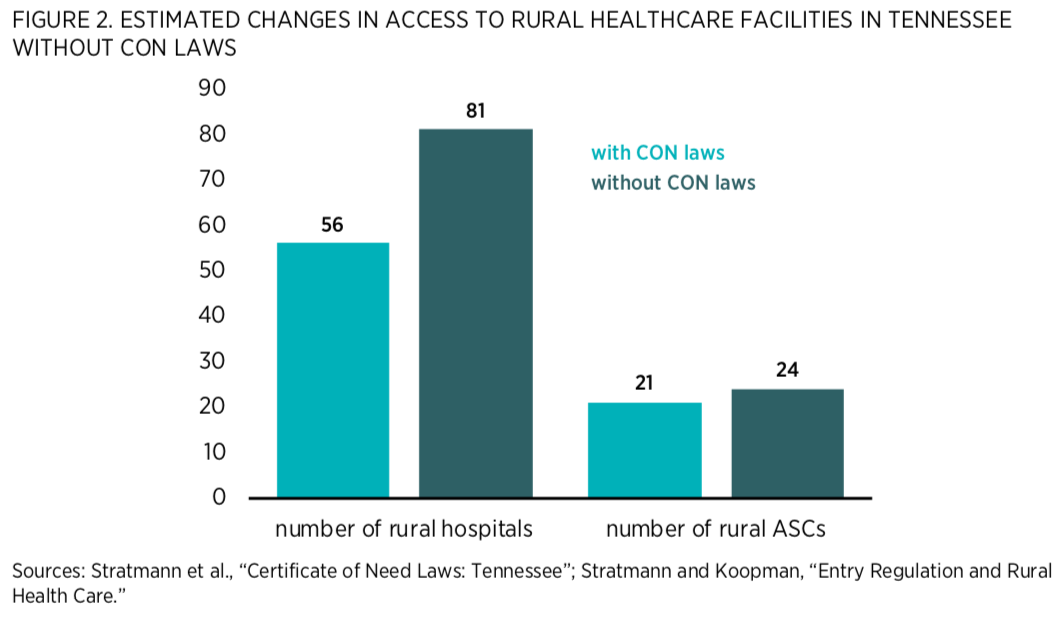
Figure 3 shows the actual as well as the estimated mortality rates following heart attack, heart failure, and pneumonia.
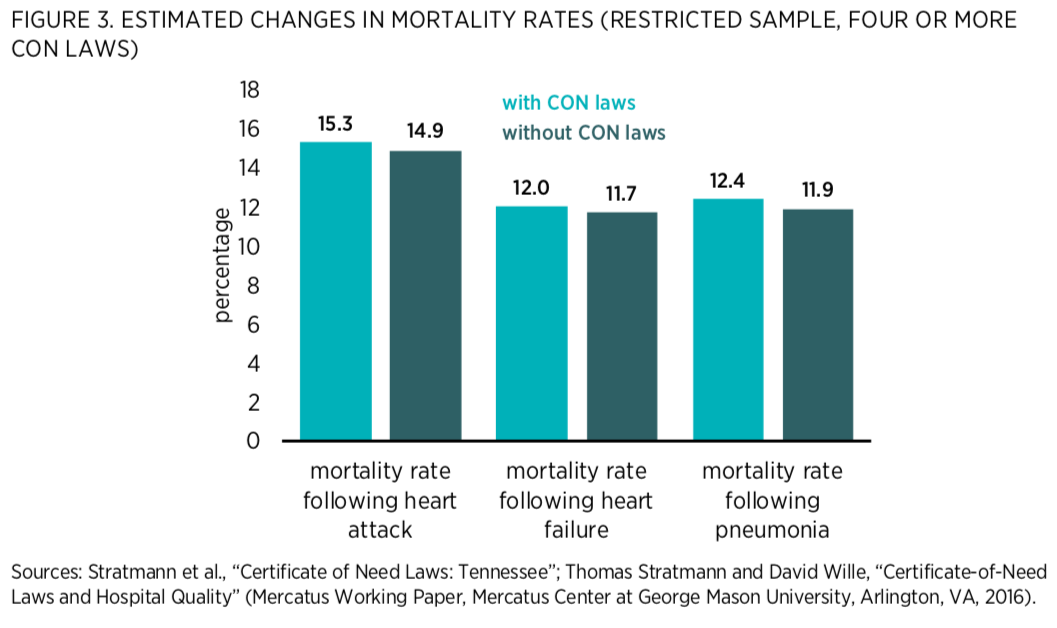
Figure 4 shows the actual as well as estimated readmission rates following heart attack and heart failure. In addition, researchers estimate that post-surgery complications would be approximately 5.7 percent lower and that the share of patients rating their hospital experience a 9 or 10 out of 10 would be approximately 4.6 percent higher in a Tennessee without CON laws.
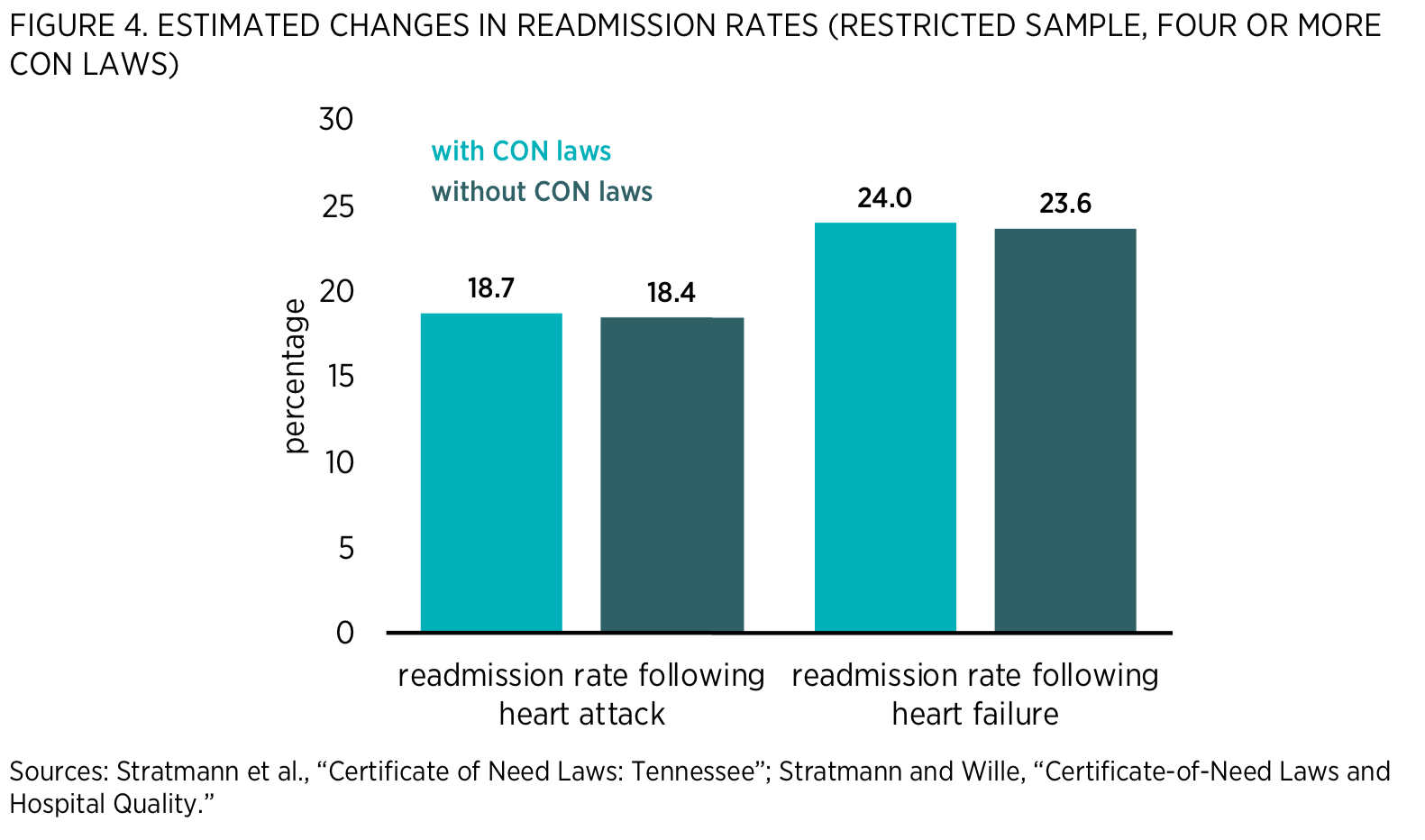
Finally, economists estimate that annual per capital health care spending would be approximately $220 lower in a Tennessee without CON.
Reform Options
The weight of evidence suggests that a full repeal of CON laws would expand access to healthcare in Tennessee that is of both high quality and low cost. Repeal might be scheduled to take effect in the near future or at a later date. Alternatively, policymakers might phase in repeal by requiring the CON board to approve an ever-larger percentage of applications over a certain number of years.
Short of full repeal, policymakers have a number of options to reform the program and limit its negative effects. For example, the state might eliminate specific CON requirements. Promising candidates include
- restrictions on access to services used by vulnerable populations such as the CONs for opiate addiction treatment and psychiatric care,
- CONs for services that are unlikely to be overprescribed such as burn care or neonatal intensive care units;
- CONs for services that require limited capital expenditures, such as home healthcare; and
- restrictions on access to low-cost modes of care such as ambulatory surgery centers and hospice facilities.
Policymakers might also consider a number of options to ease the administrative burden of CON laws. For example, they might reduce fees, reduce the administrative burden of the application process, or require
incumbents who unsuccessfully challenge an entrant’s CON application to pay the entrant’s legal and compliance costs.
The criteria used to evaluate a CON application might also be changed. For example, a CON application should not be rejected to prevent the provision of duplicative services. Such a rejection would guarantee monopoly status for the current service providers, and healthcare monopolies are associated with high-cost, low-quality care. Utilization rate is another poor criterion. For example, if an existing hospital knows that potential competitors are less likely to obtain CONs if it keeps its bed utilization rate low, then it faces an incentive to acquire more beds than it needs. This is exactly the sort of unnecessary capital expenditure that CON was supposed to discourage.
In addition, the state might raise the monetary threshold of an investment that necessitates a CON. It might also require the CON board to seek input from parties without financial interest in the outcome or from parties dedicated to the preservation of market competition, such as antitrust authorities at the FTC.
Finally, policymakers might consider a number of options that would increase the transparency of the CON program and make legislative oversight easier. One option would be to require the board to regularly disclose the CON approval rate. The board could also be required to report the share of applications opposed by incumbent providers as well as the different approval rates for opposed and unopposed applications. The board could be required to ask applicants to estimate their costs of complying with the CON application and then regularly report these numbers to the public. And finally, the board could be required to follow up with denied applicants to evaluate how the denial has affected their provision of services.
Concluding Remarks
Given the substantial evidence that CON laws do not achieve their stated goals, one may wonder why these laws continue to exist in so much of the country. The explanation seems to lie in the special-interest theory of regulation. Specifically, CON laws perform a valuable function for incumbent providers of healthcare services by limiting their exposure to new competition. Indeed, recent evidence suggests that special interest groups are able to use political donations to increase the odds that their CON requests will be granted. This aspect of CON laws helps explain why economists as well as antitrust authorities have long argued that these regulations are anticompetitive and harmful to consumers.
For those who are interested in further details on the effects of CON laws on spending patterns, I have also attached my paper, “Do Certificate-of-Need Laws Limit Spending?” Like all Mercatus Center research, it has been through a rigorous, double-blind peer review process.
Thank you again for the opportunity to share my research with you. I look forward to answering any questions you may have.

